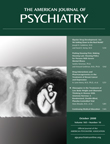In Impulse Control Disorders, Jon E. Grant tackles a subject that has perplexed psychiatry worldwide for centuries. Grant, on the faculty of the University of Minnesota, provides a great deal of information on impulse control disorders, but the result is a book that can best be described as “exasperating.”
Any doubts that the subject of
Impulse Control Disorders is one that psychiatry has struggled with, with less than impressive outcomes, can be laid to rest by comparing the 1882 trial of President Garfield’s overtly mentally ill assassin, Charles Guiteau, with the 1982 trial of John Hinckley, Jr., who attempted to assassinate President Reagan. Although both were held at St. Elizabeths Hospital in Washington, D.C., Guiteau was hanged following his trial, whereas Hinckley is now released periodically for visits with his family. In addressing the subject, it is important to put
Impulse Control Disorders in a contextual framework in the American psychiatric lexicon. To understand the values or the underpinnings of our current nosology, one would do well to consult Sadler’s
Values and Psychiatric Diagnosis (1) . Grant does not address the moral conundrums that surround these disorders, which are the quintessential example of the “mad versus bad” debate in psychiatry and the law. This is well exemplified by the oft-cited phrase, “The line between an irresistible impulse and an impulse not resisted is probably no sharper than that between twilight and dusk”
(2) .
Grant starts the book by providing clinical characteristics of impulse control disorders. He includes pathological gambling, kleptomania, trichotillomania, pyromania, intermittent explosive disorder, pathological skin picking, compulsive buying, compulsive sexual behavior, Internet addiction, self-injurious behavior, and binge eating disorder. The book focuses almost exclusively on intermittent explosive disorder, pathological gambling, and kleptomania.
Grant then turns his attention to models for understanding impulse control disorders. The excellent article by Moeller et al., “Psychiatric Aspects of Impulsivity,” covers this territory in a more precise, concise fashion
(3) .
Grant does a very good job in explicating possible etiologies for impulse control disorders, the relationship between these disorders and addictions, and the comorbidity and interactions among the impulse control disorders themselves. Chapters on the assessment and treatment of impulse control disorders are less thorough.
Much of the exasperation I experienced in reading this work is the way in which the book is organized and referenced so as to advance Grant’s perspectives on these disorders. The author informs us repeatedly that impulse control disorders are of high prevalence. This is the result of much of his own work, but these research results are not consistent with much of the other research in this area.
Material presented in one chapter is often repeated in another, sometimes using almost exactly the same words. For example, compare “Female pathological gamblers, on the other hand, tend to report problems with nonstrategic, less interpersonally interactive forms of gambling such as slot machines or bingo” (p. 3) with “Female as compared with male pathological gamblers tend to have problems with nonstrategic forms of gambling such as slot machines and bingo” (p. 50).
The use of references is also confusing. Statements which cry out for a reference go without citation (e.g., “Neurobiological studies suggest that individuals with impulse control disorders may have neural features…distinct from brain activation patterns observed in cue-provocation studies of obsessive compulsive disorders”). Statements which would seem to not require a citation frequently have a reference (e.g., “Compared with adulthood, adolescence is a time of intense emotional and physical changes”). The book is filled with interesting tables, some of which are well referenced, but most have no references at all; it is unclear from where this information comes.
The basis for informing readers in detail about some impulse control disorders but not others is entirely unclear. For example, in the section on assessment, trichotillomania and pathological gambling are extensively covered, while intermittent explosive disorder and pyromania receive no coverage at all. Further, simply listing diagnostic criteria for a disorder does not present a useful scheme for the clinician assessing a patient who might have an impulse control disorder. In the section on treatment, the treatment of pathological gambling receives more coverage than the treatment of all the other impulse control disorders together.
In the introduction, the reader is told that many clinicians are not familiar with impulse control disorders and that this book will provide “a detailed method of assessing and treating these behaviors.” The reader is further informed that this book will serve as a guide to both new and experienced clinicians, as well as a basis for researchers. Impulse Control Disorders most satisfactorily meets the last of these aims. The book is quite useful for investigators who are researching impulse control disorders, because Grant provides many interesting hypotheses about impulse control disorders, interesting speculations on interactions among the impulse control disorders, conjectures on comorbidities of impulse control disorders, and an adequate reference list. The book’s subtitle includes “A Clinician’s Guide.” It is not really that. The book provides too much that does not relate to clinicians and too little that clinicians really need.

